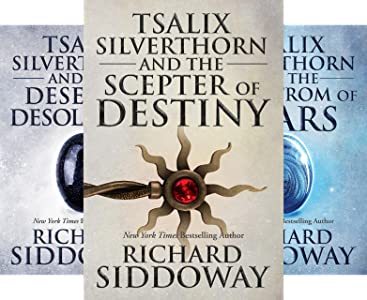Review: Tsalix Silverthorn and the Glittering Peak by Richard Siddoway
“The counsel I would give you is that it is better to use it to heal than to wound.”
SPOILERS AHEAD – Read at your own peril*
2 brothers. 1 throne. World War.
Twin princes, Abadon and Johona, are tearing the land apart over their father’s throne while Tsalix and three men are sent to retrieve prophesied talismans that could unlock the Scepter of Power and restore peace.

In the fourth instalment, the death of the King creates an even greater urgency to recover the Scepter of Destiny. The final battle between the twin princes to replace their father as ruler over the Kingdom of Sodizen is imminent.
Abadon plans strategically to steal the talismans from Tsalix and his men, but freeing the sceptre from its resting place in the mountain turns out to be more difficult than imagined, and using it wisely proves to be fit only for the worthy.
The first thing I’ll say for author Richard Siddoway is that he knows the genre. Each instalment in the Silverthorn series has been an amalgamation of every high fantasy you will have read so far. The worldbuilding, the unpronounceable names, the monarchy, the prophecies – they are all trope staples of the genre and, to his credit, Siddoway crafts them well.
Towards the beginning, I always need a bit of time to get used to Siddoway's notoriously short chapters again. Often, they only afford vital scenes a snapshot space to develop and this simply doesn't give space to Siddoway's writing to breathe. But, unlike other fantasy novels, I would argue that this structure does keep you reading for longer. In fact, I found myself reading Tsalix Silverthorn and the Glittering Peak for far longer than I meant to.
“You demand everyone live the way you want them to live. They have no freedom. What a plan for misery."
I always enjoy religious allusion in high fantasy and, between the Jekyll and Hyde twin princes, Siddoway certainly delivers.
Johona seems to draw his name from several wise biblical figures: Noah, John, and Jonah all seem to dwell in the guidance he offers protagonist Tsalix. In this way, we watch Tsalix develop his own faith and confidence in his morality.
Abadon is likewise aptly named although his character falls a little short.
Having read the first book of this series, I’ve seen where Abadon began and now I’m finding myself mourning a little for what Siddoway could have done with him. The ‘two sides of the same coin’ trope is riveting because it shows us how thin the line was between those two sides. But with the “psychopath” prince and the “noble” prince, I keep finding myself aching for how this could be twisted and reshaped in interesting ways.
Chapter 68 is a pivotal dialogue scene between the two brothers that could have delivered some interesting perspectives but it falls short. Where I hoped to see some of Siddoway's fascinating perspective on the classic genre, all I saw was the age-old "Compliance means peace!" "But brother, what about the people's free will?!" It was a letdown from Siddoway given his creative relationship with the genre thus far.

That brings me to my next point: Wow. That is a lot of male characters.
If you’re a lover of the fantasy genre, like me, you’ll be just as familiar with how chock-full of men it is. Much of the love for the genre comes from the classics – Dune, Lord of the Rings – which can be forgiven (to a degree) for being so androcentric. But the passion and enthusiasm for new blood in the genre – recently, Six of Crows and the Grishaverse, His Dark Materials, Game of Thrones – is being driven by a rapidly growing demographic of minority readers who are finally finding themselves in books that have historically been written without them.
The thing that stood out the most for me while reading Tsalix Silverthorn and the Glittering Peak is that it feels like reading a classic. It succeeds at its worldbuilding because you can feel the immersion of an author who has written this land as a second home – it has the Tolkien factor. Every new prophesied item or fabled mountain has that nostalgic ring of classic fantasy to it. Every character feels like the white knight hero or easy villain so we know exactly who to point and cheer or boo at.
And that would be fine if this was a classic fantasy.
Like I’ve said, Siddoway knows the genre. But this falls short of the current market. Tsalix Silverthorn and the Glittering Peak, releasing this year, does not have the excuse of sitting in classic territory yet. It needs to bring that extra kick into the genre or it can’t stand up against the current bestsellers in the market that are introducing female characters, queer characters, and people of colour into the genre in major roles for the first time in mainstream fantasy. The market has shifted and this means that otherwise would-be classic competitors are falling behind: Silverthorn included.
The dragon sisters were a nice touch but they lacked that confidence of existence the other characters had. Every scene feels as though they must prove themselves worthy to be included in the story.
I am a fan of Siddoway’s latest instalment into the series and the story is a compelling one but, for this book to have kept the saga in its glory, it needed to bring something extra and it hasn’t.
